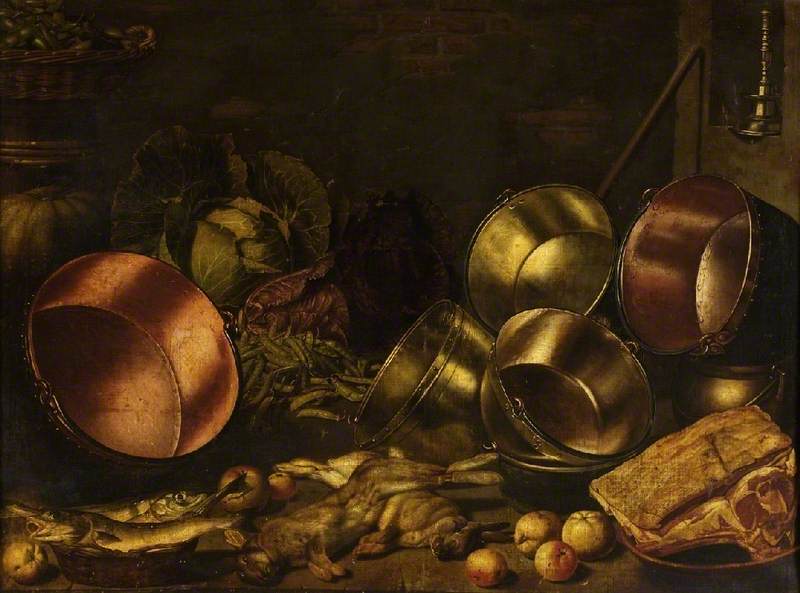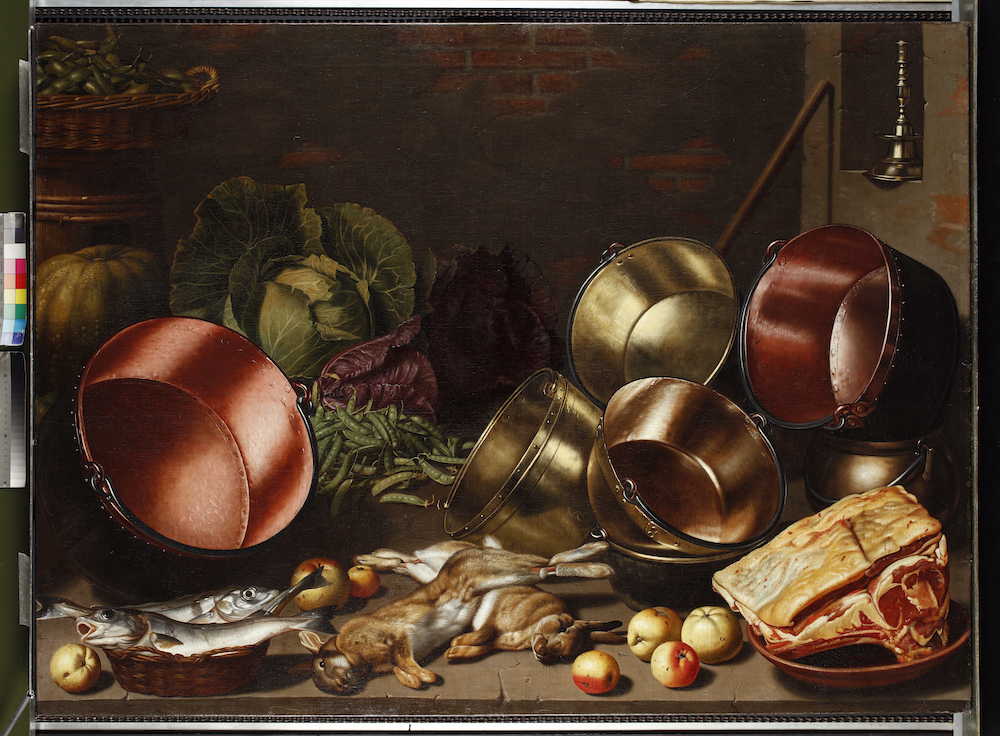From roast to raw meat: a cooking process reversed through the conservator’s brush
This substantial canvas of a Dutch pantry has been specially cleaned for Feast & Fast by Victoria Sutcliffe at Cambridge University’s Hamilton Kerr Institute. During her conservation treatment, Vicky discovered that the painting is a rare example of a 17th-century painting not lined at a later date. (Lining, with an additional canvas layer adhered to the reverse, was a common historical restoration technique used to stabilise and reinforce paintings). Removal of the old, discoloured, patchy varnish has greatly improved the readability of the composition, and revealed van Schooten’s initials ‘F.V.S.’ on the stone ledge at the bottom of the canvas. The varnish’s removal has also revealed van Schooten’s bravura in capturing diverse colours and textures, which had become dull and hard to discern. His evident delight in the accurate recording of details tells us a great deal about the sourcing and preparation of food in 17th-century Haarlem.


The painting is filled with various locally sourced produce of the sort that would have been enjoyed in September or October, including pumpkins, cabbages, and apples. While peas were mainly a summer vegetable, late crops were sown in July for autumn harvesting (like the ones shown here) and were then dried to convert them into store cupboard food. Glistening herring, a mainstay of the Dutch economy and diet, await gutting on a pewter plate. Van Schooten has even bothered to record the leg wounds at ankle level on both rabbits, revealing their method of capture in snares. The slab of beef sirloin in the right foreground was always assumed to have been roasted, due to the brownish colour of the meat and the golden colour of the fat. However, the conservator’s brush has revealed a slab of uncooked and completely raw meat, thereby miraculously reversing a cooking process.
Cleaning has also revealed the vibrant colour range and reflective surfaces of the highly polished pots and pans, some stacked, others deliberately angled to catch the light. The different colours reveal that they were made from different types of metal: copper, and copper alloys, such as brass and latten. All of them have sparkling insides, but only some of them have shiny outsides, which reveals that they were used for different kinds of cooking over different kinds of fuel. Those pots with shiny outsides must have been used for making preserves (or other food that required precise temperature control) over charcoal. We know this because burning charcoal releases carbon monoxide that reduces any oxides or other stains on copper, leaving a pan’s surface remarkably clean and shiny. Although charcoal was more expensive than wood, it was easier to control. Those pans with blackened outsides must have been used for general meat and vegetable cookery over an open wood fire, as the black colour represents an even sooty deposit. General cooking was done over wood, which was cheap but harder to control.
Van Schooten’s virtuoso rendition of light on burnished metal belies modern assumptions of the lack of cleanliness in historical kitchens. His shining pans are a testimony to the pride of the servant in his or her work for their master and mistress, as noted by Ann Cook, in her Professed Cookery of c.1760:
I can observe a secret Pleasure to attend you after your Work is done, as you sit admiring your clean Pots, Pans, Pewter, Dressers, &c &c so I am convinced a secret Pleasure reigns in every Servant’s bosom to discharge their several Duties to those two Worthies they serve.
But it was more than a matter of personal pride or pleasing one’s boss: all pans had to be kept scrupulously clean and free of food residues to avoid the creation of toxic copper sulphate, which could inadvertently cause food poisoning.





